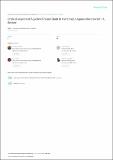| dc.contributor.author | E Ogello, D Kyule, K Obiero, J Munguti, L Musalia, D Liti, J Kirimi, J Sabwa | |
| dc.date.accessioned | 2022-01-21T13:44:16Z | |
| dc.date.available | 2022-01-21T13:44:16Z | |
| dc.date.issued | 2021 | |
| dc.identifier.uri | https://repository.maseno.ac.ke/handle/123456789/4478 | |
| dc.description.abstract | This article reviews critical aspects of the aquafeed value chain in the Kenyan aquaculture sector. Aquaculture
production in Kenya has grown steadily in recent years, to more than 18,000 tons in 2019. Due to the growing
demand for fish and fish products, there has been a gradual shift from extensive to semi-intensive to moderately
intensive aquaculture systems, leading to an increased demand for high quality commercial fish feeds. The
current annual demand for fish feed in Kenya is estimated at 34,000 tons. It is the lack of sufficient and
high-quality local fish feed production that has created a market for fish feed importers, which is currently
estimated at 7,000 tons annually. However, the imported fish feed is expensive for most fish farmers, leading to
low production. Local fish feed production through home-based formulation should be driven by fish farmers to
contain the rising cost of feeds. Most cottage feed manufacturers produce mash, crumbles or sinking pellets
because they lack extruder for making floating pellets, hence the need for quality control in the aqua-feed sector.
Fish feed producers are weakly covered by financial services providers, hence the inability to compete
effectively with other value chains. The paper outlines five key actors in the aqua-feed value chain from
production to marketing. These include; raw material (ingredients) suppliers, feed manufacturers (feed
formulators), distributors/wholesalers, retailers, and customers who are fish farmers. We recommend
intensification of local aqua-feed production using locally available materials to reduce the importation. This will
ensure the long term economic and ecological sustainability of the aquaculture sector. There is a need for
favourable policies to lower importation rates for raw materials as a way of boosting the availability of additional
feed resources and inputs | en_US |
| dc.publisher | Canadian Center of Science and Education | en_US |
| dc.subject | actors, aqua-feed, value chain, Kenya | en_US |
| dc.title | Critical aspects of aquafeed value chain in the Kenyan aquaculture sector | en_US |
| dc.type | Article | en_US |

